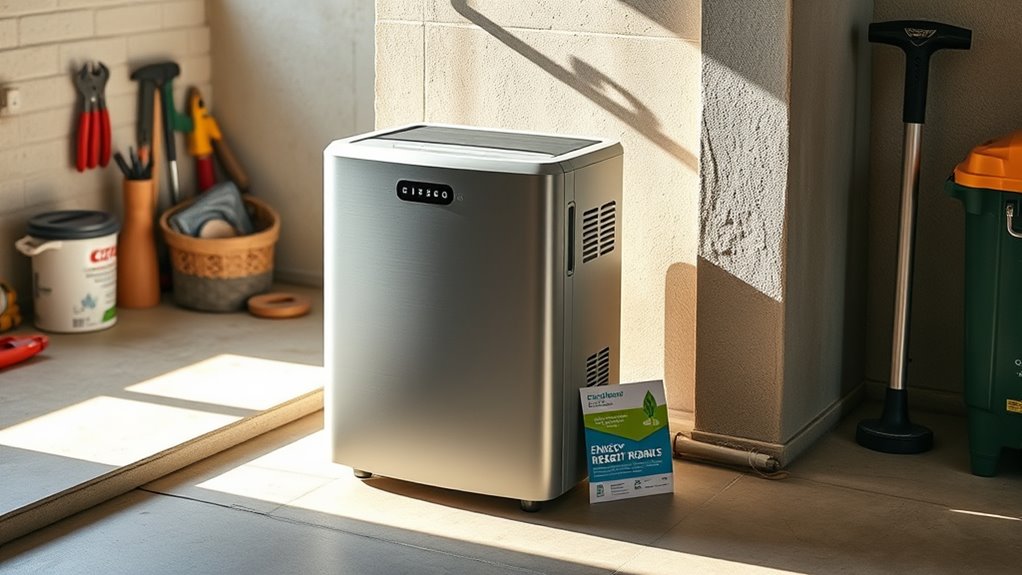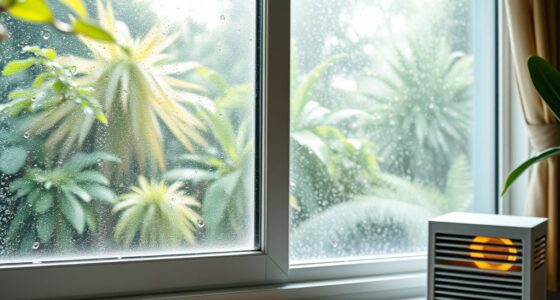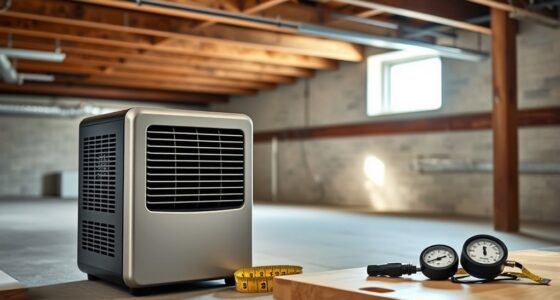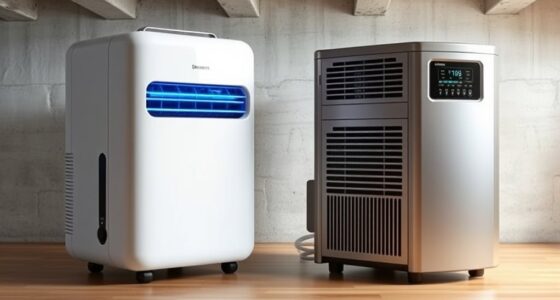To save money and improve indoor air quality, look for dehumidifiers with high energy efficiency labels like Energy Star. Proper maintenance and ideal placement can boost their performance and longevity, reducing energy bills. Many regions also offer rebates or incentives for purchasing efficient models, which can lower your upfront costs. Staying informed about these programs helps you maximize savings. Keep going to discover more tips on choosing and maintaining a cost-effective dehumidifier.
Key Takeaways
- Look for Energy Star-certified dehumidifiers to qualify for energy rebate programs.
- Proper maintenance of your dehumidifier enhances efficiency and may increase rebate eligibility.
- Many regions offer rebates or incentives for purchasing energy-efficient appliances, including dehumidifiers.
- Installing the right size and setting humidity levels around 50% can maximize energy savings and rebates.
- Keep documentation of purchase and specifications to streamline rebate claims and maximize savings.
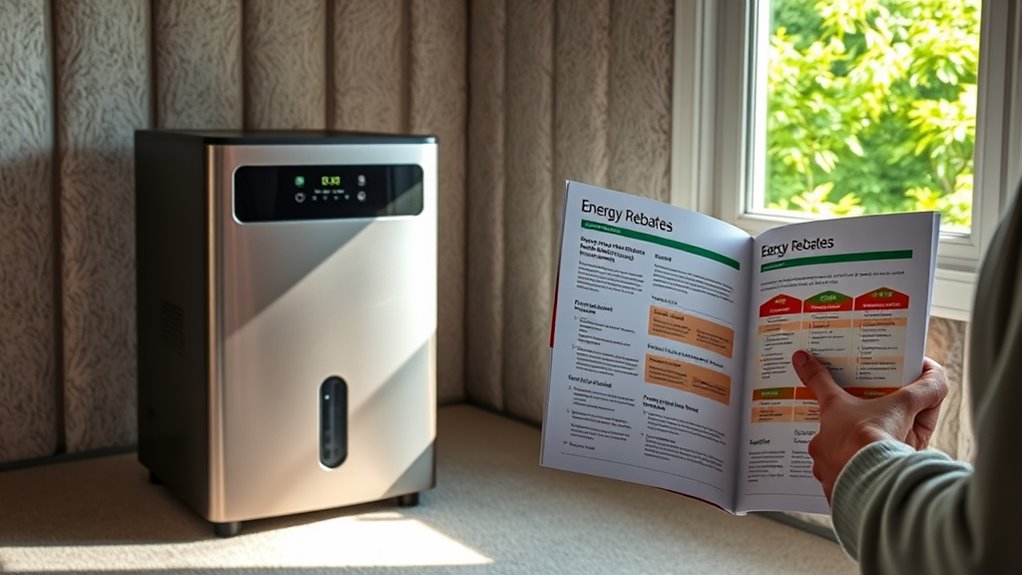
If you’re considering ways to improve your home’s air quality and reduce energy costs, investing in a dehumidifier is a smart move. Not only does it help control excess moisture, but it can also lead to notable energy savings, especially when you understand how to maintain your device properly. Humidifier maintenance is essential for keeping your dehumidifier running efficiently. Regularly cleaning the filters, coils, and water reservoir prevents mold growth and ensures the unit operates smoothly. When your dehumidifier is well-maintained, it doesn’t have to work as hard, which translates into lower energy consumption and potentially lower utility bills.
Understanding energy efficiency tips can maximize your investment and make your home more comfortable. For instance, placing the dehumidifier in a central location, away from barriers, allows for better air circulation and reduces the workload. Also, setting the right humidity level—around 50%—helps prevent overworking the device, saving energy without sacrificing comfort. Using a programmable timer can turn the unit off during times when humidity isn’t a concern, further reducing unnecessary energy use. These small adjustments make a big difference in how much energy your dehumidifier consumes over time.
Additionally, choosing an energy-efficient model with a high contrast ratio can ensure better performance and longer-lasting operation. In many regions, government incentives and energy rebates are available for homeowners who purchase energy-efficient appliances, including dehumidifiers. To take advantage of these rebates, you should look into local programs before buying. These rebates often require that your new dehumidifier meets specific energy efficiency standards, so check the Energy Star label or other certification details. Applying for rebates typically involves submitting proof of purchase and product specifications, which can greatly offset the initial cost. Keep in mind that these incentives are designed to promote eco-friendly appliances, helping you reduce your carbon footprint while saving money.
Investing in an energy-efficient dehumidifier isn’t just about immediate savings; it’s also a long-term strategy to lower energy costs and improve your indoor air quality. Proper humidifier maintenance ensures your unit operates at peak efficiency, while following energy efficiency tips extends its lifespan and minimizes operating expenses. Combining these practices with available energy rebates can make upgrading your home’s dehumidification system more affordable and rewarding. By staying informed about rebate programs and maintaining your device properly, you’re taking smart steps toward a healthier, more energy-conscious home.
Frequently Asked Questions
Are Dehumidifiers Eligible for Rebates in All States?
You might wonder if dehumidifiers qualify for rebates everywhere. Rebate eligibility criteria vary by state, so it is crucial to check your specific state’s requirements. Some states offer incentives for energy-efficient appliances, but others don’t. To find out, visit your state’s energy department website or local utility programs. This way, you can determine if your dehumidifier purchase meets the criteria for rebate programs available in your area.
How Long Does the Rebate Application Process Typically Take?
Ever wonder how long you’ll wait for your rebate? Usually, the rebate processing and application timeline can take anywhere from a few weeks to a couple of months, depending on the program and completeness of your submission. Being thorough with your paperwork helps speed things up. You’ll receive updates during the process, so stay patient—once approved, the rebate funds are on their way to you!
Can I Combine Dehumidifier Rebates With Other Home Energy Incentives?
You can often combine dehumidifier rebates with other home energy incentives, but it depends on the specific rebate program limitations. Check each program’s rules to see if stacking incentives is allowed. Combining these rebates can boost your seasonal energy savings, making upgrades more affordable. Always verify eligibility and restrictions before applying, so you maximize your benefits without unexpected hurdles.
Are There Specific Brands or Models That Qualify for Rebates?
You should check the specific brand eligibility and model specifications for rebate programs, as not all dehumidifier brands qualify. Look for ENERGY STAR-certified models that meet program criteria, since these often qualify for rebates. Visit the rebate provider’s website or contact them directly to confirm which brands and models are eligible. By doing this, you guarantee you’re choosing a qualifying dehumidifier that maximizes your rebate benefits.
Do Rebates Cover Commercial or Only Residential Dehumidifiers?
Curious about rebates for commercial applications? You’ll find that most energy rebates primarily cover residential dehumidifiers, with limited options for industrial regulations. While some programs may include commercial models, they’re often stricter and less common. To maximize your benefits, check with local programs or utility providers. You might need to meet specific criteria or apply through specialized channels. Understanding these details helps you harness rebates effectively and stay compliant with industrial regulations.
Conclusion
By choosing a dehumidifier, understanding rebates, and taking action, you’re protecting your home, saving your energy, and supporting your budget. When you invest wisely, you improve your comfort, reduce your costs, and contribute to a healthier environment. Making informed decisions today leads to a more comfortable tomorrow, a more efficient home, and a brighter future. So, embrace the opportunities, seize the savings, and enjoy the benefits of smarter living.
